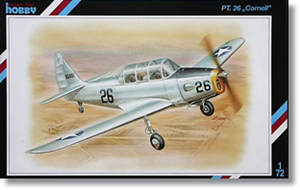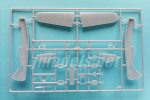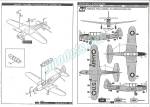
De un vistazo – Quick look
MATERIAL Y PIEZAS
MEDIA & PARTS:
- Plástico inyectado (25 piezas), fotograbado (23 piezas), resina (1 pieza), plástico vacuformado (2 piezas).
- Injected plastic (25 parts), PE (23 parts), resin (1 part), vacformed plastic (2 parts).
CALCAS – DECALS:
- Insignias norteamericanas y noruegas, líneas de no pisar, matrículas, numerales y varios estarcidos. Bien impresas, finas y sin exceso de película.
- US and Norwegian markings, no step lines, codes and several stencils. Well printed, thin and without excess of carrier film.
OPCIONES – OPTIONS:
- Fairchild PT-26 Cornell, Fuerza Aérea del Ejército de los EE.UU., 1943.
- Fairchild PT-26 Cornell empleado para entrenar pilotos noruegos. Real Fuerza Aérea Canadiense, base Little Norway, Toronto (Canadá), agosto de 1942- julio de 1944.
- Fairchild PT-26 Cornell, U.S. Army Air Force, 1943.
- Fairchild PT-26 Cornell, used in training Norwegian pilots, RCAF. Little Norway base, Toronto (Canada), August 1942 – July 1944.
INSTRUCCIONES – INSTRUCTIONS:
- Folleto doblado tamaño A5 de seis páginas. Contiene referencia histórica, plano de piezas, cuatro pasos principales de montaje y perfiles para pintar y poner calcas. Códigos de pintura de Humbrol esmaltes. Simples y claras.
- 6-page A5 leaflet. It contains a historical reference, parts plan, four main assembly sequences and profiles to paint and set decals. Simple and clear.
LO MEJOR – THE BEST:
- Avión inusual. Buen detalle interior.
- Unusual topic. Good interior detail.
LO PEOR – THE WORST:
- Unión de fuselaje y alas.
- Fuselage-wing attachment.
VALORACIÓN – CONCLUSION:
- Única a la escala actualmente y destinada a modelistas con experiencia. Bien detallada interiormente y con no demasiado trabajo de montaje comparada con otras de su estilo.
- Only kit of the type at the scale today, aimed at experienced modellers. Fine internal detail and not too difficult compared to other short-runs.

Hoy traigo a las revisiones este Cornell de Special Hobby, una maqueta aún no demasiado antigua y original de MPM, la única de este entrenador a la escala hoy. Echándole un vistazo a las piezas, se ve lo mucho que ha avanzado la tecnología del fabricante en unas décadas.
La caja trae un bastidor de plástico, una plancha de fotograbados, una pieza de resina, dos cubiertas vacuformadas, las calcas y las instrucciones. Todo va metido en una bolsa, excepto las calcas y los fotograbados que vienen en una bolsa separada.
El plástico del bastidor principal es duro y rígido, pero fino y bien moldeado. El molde es bastante limpio, sólo hay ligero plástico sobrante en las ruedas y aún menos en las alas. No hay marcas visibles ni siquiera en los confines de la carlinga. Las líneas de paneles y registros, aunque no abundantes, son finas y están bien grabadas.
Siendo un avión de apariencia tan simple, es normal que la mayor parte de piezas esté destinada a detallar la carlinga. Los lados internos del fuselaje muestran parte de la estructura interna, aunque de manera un poco tenue, sin excesivo relieve. La carlinga cuenta con un suelo para los dos puestos, dos asientos finos y bien moldeados con cinturones de fotograbado, pedales del mismo material, dos palancas, instrumentos de vuelo a los lados con palancas de fotograbado, un panel trasero y otro intermedio, que es precisamente la única pieza de resina de la maqueta. Como en tantas otras de este tipo, no hay guía para pegar la carlinga al fuselaje. Las únicas piezas sobrantes son la parte superior del fuselaje, alternativa para el PT-19 con dos carlingas abiertas separadas, y algunas piezas de fotograbado.
Exteriormente el fuselaje tiene buen detalle, las dos mitades muestran el entelado trasero adecuadamente. Las raíces alares están incluidas en las mitades y no cuentan con ningún tipo de sujeción para las alas. Sin embargo, sí hay ranuras a cola para introducir los estabilizadores. La estructura del timón de dirección resulta un poco tenue y acaso no sea lo más acertado del fuselaje.
La parte inferior del morro cuenta con una pieza separada para simular una salida del motor y un rebaje en el lado derecho para los escapes. Al ser un molde compartido, no estoy seguro de si estos son plenamente correctos. Son dos tubitos finos cuya posición exacta no está muy clara en las instrucciones que, precisamente en este punto, son idénticas a las del PT-19 de MPM. Para cubrir la carlinga hay dos cubiertas vacuformadas finas y bien fabricadas.
El frontal del fuselaje consta de una pieza con aberturas para diferentes tomas de aire y ventilación más una apertura central para colocar la hélice. Esta es fina y muestra torsión convincente. Está detallada en el buje con una pequeña pieza de fotograbado.
Las alas y estabilizadores son piezas completas y me parecen de grosor adecuado para la escala. Como he dicho, las líneas de panel y registros son finas y están bien trazadas. Las superficies de control están correctamente delimitadas y poseen pequeños actuadores a escala, sin embargo, la representación del entelado es demasiado tenue. Como también he mencionado arriba, las alas carecen de aletas de unión con el fuselaje.
El tren de aterrizaje es simple y lo componen una rueda de cola, dos patas y dos ruedas. Las patas son finas y están provistas de amortiguación. Las ruedas son sencillas, sin dibujo en el neumático y tapacubos bien marcados.
Las calcas tienen buena apariencia y parecen muy finas. No hay exceso de soporte. La hoja muestra escarapelas norteamericanas y marcas noruegas para la cola y las alas, además de matrículas, numerales, líneas de pisado y algunos estarcidos.
Las instrucciones vienen impresas en un folleto doblado de tamaño A5 de seis páginas sueltas. Contienen un resumen histórico en varios idiomas, un plano numerado de piezas, cuatro pasos generales de montaje sin numerar y perfiles para dos opciones de pintura. Los colores de referencia pertenecen a la gama esmalte de Humbrol. Curiosamente, no se incluye ninguna versión propiamente canadiense, habiendo sido la RCAF el mayor usuario de este avión. La versión noruega es atractiva de pintar, sin embargo, tras algunas pesquisas en internet, sospecho que la norteamericana es una copia de un avión actual conservado sin los colores auténticos de 1943.
En resumen, esta es una maqueta claramente destinada a modelistas con experiencia a los que no debe resultar muy difícil de montar. La maqueta está bien detallada por dentro y se trata de un avión poco común, incluso dentro de la larga lista de modelos desarrollados en su familia.◊

Let’´s have a look at this Cornell from Special Hobby, a not-so-old kit coming from an MPM original tooling. Still today it is the only one of this trainer at the scale. Considering the box content, it is quite evident how much the manufacturer´s technology has progressed in a few decades.
The box contains a plastic sprue, a PE fret, a resin part, two vacformed canopies, the decals and the instructions. Everything comes inside a bag, except for the decal sheet, which is bagged apart.
Plastic on the main sprue is somewhat hard and stiff, but thin and well molded. Parts are quite clean and there is only minor flash on the wheels and still less on the wing edges. No marks are on visible spots, not even on the cockpit. Registers and panel lines, though not abundant, are thin and finely engraved.
Being so a simple aircraft, it is not strange that most parts are used to enhance the cockpit. The cockpit walls show part of the internal structure, but definition is a bit soft. The cockpit includes a floor for both stations, two thin and well molded seats provided with PE belts, two sets of PE pedals, two sticks, some flight instruments on the sides with PE levers, a rear bulkhead and a middle bulkhead, which is in fact the only resin part in the kit. As in many other short-runs, there are no alignment lines to attach the cockpit to the fuselage. The only parts destined to your spare box are and alternative fuselage section with two separated open cockpits for the PT-19, and some other PE bits.
Externally the fuselage has nice detail, both halves showing the rear tapered surfaces quite convincingly. The wing roots are included in the halves and there is no slot or hole to help join the wings. Fortunately, you have a couple of slots to insert the stabilizers. The raised structure on the rudder is slightly soft and it is not the best rendered area in the fuselage. The area under the nose has a separate engine vent and a long notch on the right side to place the exhausts, two short and tiny plastic rods whose position is not very clear in the instructions and they may be incorrect for the Cornell. The instructions of the MPM PT-19 kit are not helpful because they are the same at this point.
You also have a couple of vacformed canopies which are thin and look nice. The nose front is a piece with some air vents and a drilled hole to insert the propeller, which looks thin and realistic. The spinner is detailed with a tiny PE bit.
Wings and stabilizers are complete pieces and seem to have adequate thickness for the scale. As said, panel lines and registers are thin and neatly traced. Control surfaces are well defined and are provided with tiny actuators, but the rendering of tapered surfaces is, again, too soft. As I have also mentioned above, the wings lack pins or tabs to help you fix them to the fuselage.
The landing gear is simple and comprises a tailwheel, two struts and two wheels. The struts are thin and come provided with shock absorbers. The wheels are simple too, without tread pattern and having plainly marked hubs.
Decals look fine and seem quite thin. There is no excess of carrier film on the sheet, which shows U.S. roundels and Norwegian markings for wings and tail as well as codes, numbers, no step lines and some stencils.
The instructions are printed in a 6-page leaflet that contains a brief summary about the aircraft in several languages, a numbered parts plan, four main assembly steps and profiles for two painting choices. Paint codes belong to Humbrol enamels. Curiously, none of the aircraft is a Canadian Cornell, since the RCAF was an important user. The Norwegian choice is quite attractive and colourful, but, after some research on the net, I think the US aircraft is just a copy of a preserved Cornell without its true 1943 colours.
In short, this is a kit clearly aimed at the experienced modeller, who should not have special troubles to tackle it. The kit is nicely detailed inside, and the aircraft is not very common, even in the long list of aircraft in this family of trainers.◊
Actualizado – Updated: 4 / 2022
Publicado – Published: 5 / 2020
©www.jmodels.net










Debe estar conectado para enviar un comentario.